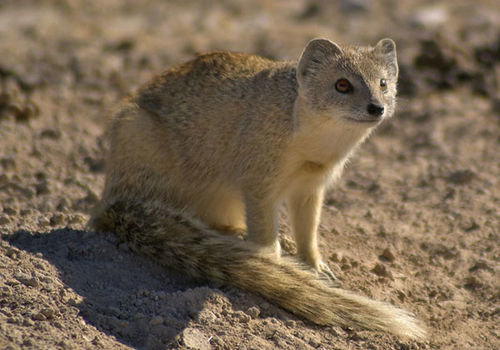
Yellow mongoose
Cynictis penicillataYellow mongoose
Introduction: The yellow mongoose (Cynictis penicillata) is a small mammal that lives in colonies of up to 20 individuals in a permanent underground complex of burrows. They have often been observed cohabiting with meerkats and ground squirrels, sharing maintenance of the burrow and adding new tunnels as necessary. The burrow has many entrances and it is the yellow mongoose that will make a latrine near one of them. When the yellow mongoose feels threatened, they will growl and secrete from their anal glands. On other occasions they can also, bark, scream and purr, and these usually quiet creatures communicate through tail movements.
Burrows are constructed on dry, open grasslands and semi-desert scrub land areas. Up to 12 subspecies of the yellow mongoose have been recorded and they can be distinguished by their size, colour, length of tail and hair. The southern subspecies tend to be larger than their northern counterparts. Yellow mongoose are also known as the red meerkat (which is confusing to everyone except the colour blind) and its predators include birds of prey, jackals, and snakes.
Distribution: The yellow mongoose is widespread in Namibia except for in coastal areas.
Diet: The yellow mongoose mainly feeds upon insects including, ants, termites, beetles and locusts. Birds, frogs, lizards, small rodents and eggs supplement their diet.
Colouring: The coat of the yellow mongoose is yellowish/tawny/grey with their underside, chin and limbs are lighter in colour. The tail is bushy, with a white tip.
Breeding: The mating season usually occurs between July and September and after a gestation period of 42 - 57 days, a litter of two young are born in a cleared out underground den.
Size: The yellow mongoose has an average body length of between 23 - 33cm and they weigh between 450 – 800g. Their tails are between 18 - 25cm.
Klein Windhoek

